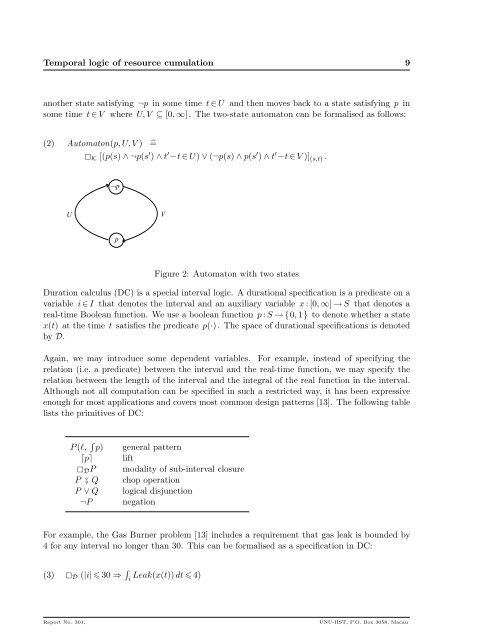IIST and UNU - UNU-IIST - United Nations University
IIST and UNU - UNU-IIST - United Nations University
IIST and UNU - UNU-IIST - United Nations University
Create successful ePaper yourself
Turn your PDF publications into a flip-book with our unique Google optimized e-Paper software.
Temporal logic of resource cumulation 9<br />
another state satisfying ¬p in some time t ∈ U <strong>and</strong> then moves back to a state satisfying p in<br />
some time t ∈ V where U, V ⊆ [0, ∞] . The two-state automaton can be formalised as follows:<br />
(2)<br />
Automaton(p, U, V ) ̂=<br />
K [(p(s) ∧ ¬p(s ′ ) ∧ t ′ −t ∈ U) ∨ (¬p(s) ∧ p(s ′ ) ∧ t ′ −t ∈ V )] (s,t) .<br />
Figure 2: Automaton with two states<br />
Duration calculus (DC) is a special interval logic. A durational specification is a predicate on a<br />
variable i ∈ I that denotes the interval <strong>and</strong> an auxiliary variable x : [0, ∞] → S that denotes a<br />
real-time Boolean function. We use a boolean function p : S → {0, 1} to denote whether a state<br />
x(t) at the time t satisfies the predicate p(·) . The space of durational specifications is denoted<br />
by D.<br />
Again, we may introduce some dependent variables. For example, instead of specifying the<br />
relation (i.e. a predicate) between the interval <strong>and</strong> the real-time function, we may specify the<br />
relation between the length of the interval <strong>and</strong> the integral of the real function in the interval.<br />
Although not all computation can be specified in such a restricted way, it has been expressive<br />
enough for most applications <strong>and</strong> covers most common design patterns [13]. The following table<br />
lists the primitives of DC:<br />
P (l, ∫ p) general pattern<br />
⌈p⌉ lift<br />
D P modality of sub-interval closure<br />
P Q chop operation<br />
P ∨ Q logical disjunction<br />
¬P negation<br />
For example, the Gas Burner problem [13] includes a requirement that gas leak is bounded by<br />
4 for any interval no longer than 30. This can be formalised as a specification in DC:<br />
(3)<br />
D (|i| 30 ⇒ ∫ i<br />
Leak(x(t)) dt 4)<br />
Report No. 301,<br />
<strong>UNU</strong>-<strong>IIST</strong>, P.O. Box 3058, Macau
















